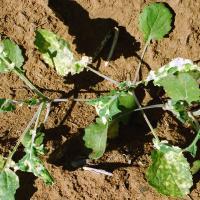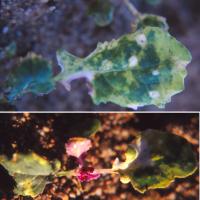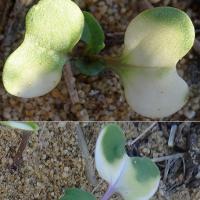Diagnosing group F herbicide damage in canola
Group F herbicides are registered for selective control of wild radish, wild mustard and wild turnip in cereals, legume crops and legume pastures. Canola is less affected than brassica weeds
What to look for
- Emerging seedlings with bleached cotyledons, that may be worse on sandier soils and on less vigorous varieties.
- Plants with yellow and white leaf blotches on sprayed leaves.
- Direct spray damage is uniformly distributed but varies with spray coverage on overlaps or boom turns.
Paddock
- Emerging seedlings have variably bleached cotyledons and pink hypocotyl and petioles
- Plants have pale green to yellow to white mottles and blotches on sprayed leaves.
- Severely affected plants are stunted with cupped leaves and stunted reddish growing point and emerging leaves.
- Plants will generally recover.
Plant
What else could it be
| Condition | Similarities | Differences |
|---|---|---|
| Diagnosing contact herbicide and spray additive damage in canola | Pale leaf blotches and streaks on sprayed leaves | Blotches caused by contact herbicide rapidly become necrotic and the plant may die |
Where did it come from?
- Stressed plants are more liable to develop symptoms. Causes include cold, wet, conditions, or frost or high temperatures after spraying.
- Widespread seedling cotyledon bleaching from diflufenican soil residue occurred in 2014 after an abnormally dry summer. Sandier soils were more affected.
Management strategies

Time of herbicide application
- Avoid late spraying crops with herbicides containing diflufenican in the season before sowing canola.
See also
Further information
Page last updated: Friday, 23 May 2014 - 3:55pm





